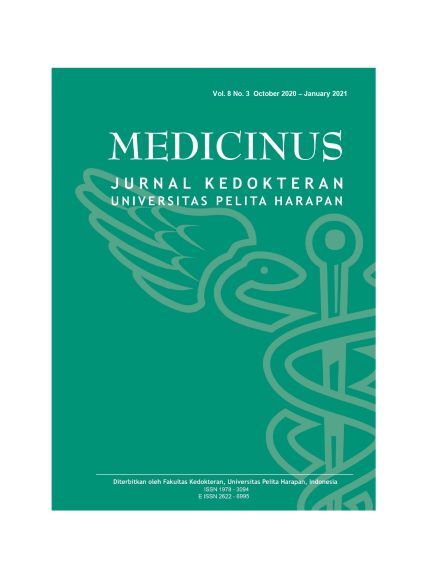Incidence And Characteristics Of Double Lumen Induced Central Venous Catheter-Related Thromboembolism In Hemodialytic Patients
DOI:
https://doi.org/10.19166/med.v8i3.3768Keywords:
catheter-related thromboembolism, double lumen central venous catheter, hemodialyticAbstract
Background: Central venous catheters (CVCs) are frequently used in patients for several indications such as cancer treatment, diagnostic monitoring, parenteral nutrition, hemodialysis, and administration of fluids, blood products or medication. Double lumen catheter induced CVCs thrombosis has not been paid into proper attention in developing countries such as Indonesia.
Aims: The aim of this study is to identify the incidence and characteristic of double lumen catheter induced CVCs thrombosis in patients undergoing hemodialysis.
Methods: This systematic review has been registered in PROSPERO (CRD42020181584). A systematic search of literature for observational and randomized controlled trial was conducted in PubMed, PubMed central, and Google Scholar through April 16, 2020. Two reviewers independently searched and selected. The risk of bias was evaluated using the Newcastle-Ottawa Quality assessment tool.
Results: A total of 408 patients were included in our study. There were 192 (47.1%) male patients. The double lumen catheter was mostly placed in the jugular vein (60%), followed by subclavian vein (25%) and femoral vein (15%). Four (1.1%) patients had deep vein thrombosis after about one month of double lumen catheter placement. All these four patients, the double lumen catheter was inserted in the femoral vein. Any other significant risk factors for thrombosis other than double lumen catheter insertion not found. Out of these four patients, one of them passed away. All patients were treated using heparin.
Conclusion: The incidence of double lumen catheter induced thrombosis is low (1.1%) in patients undergoing hemodialysis. However, further larger study is needed to confirm and find the associating factors.
References
- Hamilton H, Bodenham A. Central venous catheters. Chichester, U.K.: Wiley-Blackwell; 2009. https://doi.org/10.1002/9780470750186
- Smith Reston, Nolan Jerry. Central Venous Catheters. BMJ;2013;347:28-32.https://doi.org/10.1136/bmj.f6570
- Verso M, Agnelli G. Venous thromboembolism associated with long-term use of central venous catheters in cancer patients. J Clin Oncol. 2003; 21:3665-75.
https://doi.org/10.1200/JCO.2003.08.008 - Wechsler RJ, Spim PW, Conant EF, Steiner RM, Needleman L: Thrombosis and infection caused by thoracic venous catheters: Pathogenesis and imaging findings. AJR Am J Roentgen. 1993;16:467-471. https://doi.org/10.2214/ajr.160.3.8430537
- M Verso, G Agnelli. Venous Thromboembolism Associated with Long-term Use of Central Venous Catheters in Cancer Patients. J Clin Oncol. 2003;21:3665.
- Debourdeau P, Espie M, Chevret S. Incidence, Risk Factors, and Outcome of Central Venous Catheter-Related Thromboembolism in Breast Cancer Ptients: the CAVECCAS Study. Cancer Medicine. 2017;6:2732-44.
https://doi.org/10.1002/cam4.1201ttps://doi.org/10.1200/JCO.2003.08.008 - Wall, C., Moore, J. and Thachil, J. Catheter-related thrombosis: A practical approach. Journal of the Intensive Care Society. 2015;17:160-167.
https://doi.org/10.1177/1751143715618683 - Rooden, C., Tesselaar, M., Osanto, S., Rosendaal, F. and Huisman, M. (2005). Deep vein thrombosis associated with central venous catheters - a review. Journal of Thrombosis and Haemostasis. 2005; 3:2409-2419.
https://doi.org/10.1111/j.1538-7836.2005.01398.x - Lee AY, et al. Incidence, risk factors and outcomes of catheter-related thrombosis in adult patient with cancer. J Clin Oncol. 2006;24:1404-8.
https://doi.org/10.1200/JCO.2005.03.5600 - Spencer, TR, Mahoney. Reducing catheter-realted thrombosis using a risk reduction tool centered on catheter to vessel ratio. Thrombosis and thrombolysis J. 2017;44:427-34.
https://doi.org/10.1007/s11239-017-1569-y - Lacy J. Catheter-related venous thrombosis. Paper presented at association for vascular. 2017.
- Campisi C, Biffi R, Pittiruti M. Catheter-related central venous thrombosis: the development of a nationwide consensus paper in Italy. JAVA. 2017;12:38-46.
https://doi.org/10.2309/java.12-1-10 - Chopra V, Ratz D, Kuhn L, Lopus T, Lee A, Krein S. Peripherally inserted central catheter-related deep vein thrombosis: contemporary patterns and predictors. J thromb haemost. 2014;12:847-54. https://doi.org/10.1111/jth.12549
- Steiger E. Dysfunctioin and thrombotic complicatioins of vascular access devices. JPEN. 2006;30:1. https://doi.org/10.1177/01486071060300S1S70
- Wu, K Thiagarajan. Role of endothelium min thrombosis and hemostasis. Annual review of medicine. 1996;47:315-31. https://doi.org/10.1146/annurev.med.47.1.315
- Debourdeau P, Farge D, Beckers M, Baglin C, et al. International clinical practice guidelines for the treatment and prophylaxis of thrombosis associated with central venous catheters in patients with cancer. J Thromb Haemost. 2013;11:71-80.
https://doi.org/10.1111/jth.12071 - Young A, Billingham L, Begum G, et al. WARP Collaborative Group. Warfarin thromboprophylaxis in cancer patients with central venous catheters (WARP): an open-label randomised trial. Lancet. 2009; 373: 567-574.
https://doi.org/10.1016/S0140-6736(09)60205-1 - Akl EA, Vasireddi SR, Gunukula S, et al. Anticoagulation for patients with cancer and central venous catheters. Cochrane Database Syst Rev.2011;16:6468.
https://doi.org/10.100/14651858.CD006468.pub4
Downloads
Published
How to Cite
Issue
Section
License
Copyright (c) 2021 Margaret Merlyn Tjiang, Dimas Arsana Prayoga

This work is licensed under a Creative Commons Attribution-ShareAlike 4.0 International License.
Authors who publish with this journal agree to the following terms:
1) Authors retain copyright and grant the journal right of first publication with the work simultaneously licensed under a Creative Commons Attribution License (CC-BY-SA 4.0) that allows others to share the work with an acknowledgement of the work's authorship and initial publication in this journal.
2) Authors are able to enter into separate, additional contractual arrangements for the non-exclusive distribution of the journal's published version of the work (e.g., post it to an institutional repository or publish it in a book), with an acknowledgement of its initial publication in this journal.
3) Authors are permitted and encouraged to post their work online (e.g., in institutional repositories or on their website). The final published PDF should be used and bibliographic details that credit the publication in this journal should be included.





